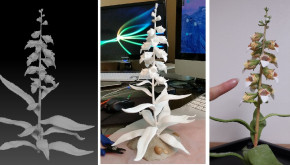
Heard about 3D prints but not sure what all the hype is about?
The University of Minnesota Extension Forestry and Natural Resources team created invasive species 3D print models for early detection identification training. During the past decade of dedicated work on many different invasive species, both terrestrial and aquatic, educators adapted and improved program instruction and display materials, including 3D prints.
3D printed invasive species model development stemmed from a problem: How do we teach folks to look for new plants and animals in the middle of Minnesota’s long, dark, cold, and snowy winter? Natural Resource professionals told us, over and over again, that they want their training during the non-field season despite the fact that that’s when it’s hardest (OK. Often impossible.) to find samples. So for years, we used high-quality digital pictures.
One day over lunch we got to wondering: Could we print scientifically-accurate, three-dimensional models of these invasive species? Ever since then, we’ve been on a massive learning curve. Extension staff reached out to an artist and digital modeler who specialized in scientific drawings. After reviewing many pictures, and samples when available, she digitally sculpted our first 3D model of Grecian foxglove, a noxious weed that displaces native vegetation and causes harmful heart palpittions. We reviewed it for accuracy: Are the tubular flowers deep enough? Are the leaves long enough? Can they be fuzzy as they are in nature? After weeks of iterative review, the artist emailed the digital file to a 3D printer, and a little over a week later, a plastic print of Grecian foxglove arrived in the mail. Next, the artist hand-painted the model, delicately painting each flower, adding fuzz to the leaves, and even mounting it in real dirt.
Our first 3D printed invasive species model was done, scientifically accurate, and beautiful! Furthermore, it’s available all the time, not just in the summer when it’s in bloom. A model is not regulated, as is common with many invasive species; regulated plants are very hard to legally transport. Lastly, a 3D model is not hazardous and doesn’t cause heart palpitations when handled.
Next, we started using the model in education, and it worked really well! So more invasive plants were ordered. Then the aquatic invasive species educators ordered invasive fish and native look-alike fish for their educational needs. It turns out that fish are even harder to manage than plants. Although they’re easily available in the environment, they get smelly and slimy fast!
As of today, we have about 20 3D printed models of invasive species and commonly-confused native species available for sale at the University of Minnesota Extension: z.umn.edu/InvasiveEd Feel free to check them out and spread the word. We’re working on additional invasive species resources that, when ready for sale, will also appear on this website.
Now when my elementary schooler comes home with the 3D printed keychain he developed at school, I can envision a clear and practical purpose for this emerging technology and his new skills. I finally understand the hype!

